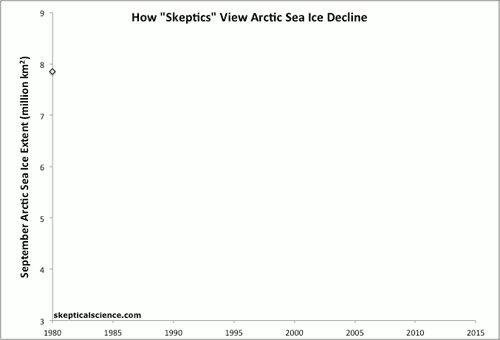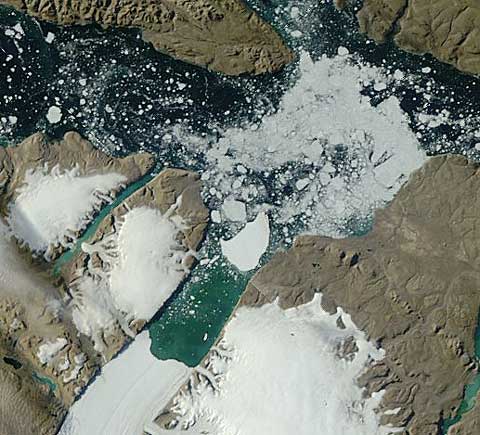In the grand tradition of the Skeptical Science global temperature “escalator“, Dana Nucitelli has put together an animated graphic that shows how cranks/deniers/faux-sceptics tend to view the Arctic sea ice decline, contrasted with how the rest of the world sees it. Dovetails nicely with my projections of the response to the melt from the crank echo chamber. If next year’s minimum is higher than this year, you can guarantee there will be shouts of recovery…
Category: Climate cranks
Arctic sea ice forecast: it’s going to be tough to stay cool
 Bad news from the Arctic is piling up as we head into the last few weeks of the melting season. The various measures of sea ice area, volume and extent are plummeting towards a new record minimum. I have therefore reviewed the history of Arctic sea ice melting seasons since 2007, and compiled my own forecast of how the rest of the year is going to pan out. Remember, you read it here first…
Bad news from the Arctic is piling up as we head into the last few weeks of the melting season. The various measures of sea ice area, volume and extent are plummeting towards a new record minimum. I have therefore reviewed the history of Arctic sea ice melting seasons since 2007, and compiled my own forecast of how the rest of the year is going to pan out. Remember, you read it here first…
When Arctic sea ice area sets a new record low in the next couple of weeks, the usual suspects ((Being Watts, Goddard, Bastardi, Jo Nova, Delingpole, the GWPF, Morano and their NZ poodle, Richard Treadgold.)) will say: “You can’t trust area, sea ice extent is the only valid metric“.
When Arctic sea ice extent sets a new record low in September, the following arguments will be run in parallel:
- There will be a frantic search for a definition of extent in which a new record was not set
- There will be a complaint that the satellite record has been blighted by the failure of a sensor and the calibrations needed to get a new sensor in operation have corrupted the record ((With added bonus insinuations of fixing and fraud by “warmist” scientists.))
- It will be claimed that it was all caused by the major Arctic storm that hit in August, and thus can’t be attributed to global warming ((In 2007, the record low was all down to winds, remember?))
- It’s cyclical — it’s all happened before, in the 1930s ((Or pick a date (any date), based on an old press clipping reporting anecdotal evidence of ice loss.)), and is therefore nothing unusual
- That it’s irrelevant, because it’s not global and not happening where anyone lives so can’t possibly matter.
When the sea ice extent and area anomalies blow out to record levels in early October because of the delayed freeze-up, there will be silence.
When the re-freeze starts, and the Arctic basin is covered in ice once more (early December), Anthony Watts will report on the record rate of ice formation, calling it a “stunning recovery“.
When a cold spell hits the Eastern US and/or Western Europe in December/January, caused by a major Arctic Oscillation excursion and the resulting big slow-moving loops in the polar jetstream ((A result of massive heat loss from the Arctic Ocean during the refreeze, see the work of Jennifer Francis, reported earlier.)), the usual suspects will cackle loudly that global warming has suffered another mortal blow from which it will never recover.
Long range forecast for the next five years, until the Arctic Ocean is ice free in summer? Rinse and repeat.
Greenland’s extraordinary summer #2: still melting
Greenland’s extraordinary summer is far from over. The ice island that broke off the Petermann glacier tongue last month — now dubbed PII-2012 — is edging its way out into the Nares Strait between Greenland and Ellesmere Island, as this satellite image, snipped from NASA’s fabulous daily Arctic Mosaic shows. For updates on events in Nares Strait, check out Dr Andreas Muenchow’s Icy Seas blog — he’s up there at the moment. Elsewhere on the great ice sheet, melting continues apace. Jason Box reports that ice sheet albedo has dipped again into record levels for the time of year, and there are reports of further extensive surface melting at the end of July. Box also reports that a recent update of the Greenland temperature record shows that current temperatures are unprecedented in at least the last 172 years. There’s also excellent coverage of the summer at Greenland melting.
Meanwhile, and rather unsurprisingly, New Zealand’s little band of climate deniers are insisting that there’s nothing special going on up North. And, equally unsurprisingly, they’re totally wrong.
Continue reading “Greenland’s extraordinary summer #2: still melting”
Fairfax and Stuff.co.nz: presenting propaganda as opinion and lies as fact
 This morning the Sydney Morning Herald published an opinion piece by well-known Aussie climate denier David Evans, and later in the day the Fairfax New Zealand news web site Stuff.co.nz decided to feature the Evans article in their science section. Two small problems for Fairfax: Evans “opinion” piece is nothing more than propaganda masquerading as opinion, and contains straightforward lies about our understanding of climate.
This morning the Sydney Morning Herald published an opinion piece by well-known Aussie climate denier David Evans, and later in the day the Fairfax New Zealand news web site Stuff.co.nz decided to feature the Evans article in their science section. Two small problems for Fairfax: Evans “opinion” piece is nothing more than propaganda masquerading as opinion, and contains straightforward lies about our understanding of climate.
We last met Evans back in April, when he unleashed on an unsuspecting world a risible political analysis of those who want action on climate change. Even so, the SMH, for reasons best known to themselves, chose to let him loose on their pages to present a “scientific” argument. The problem? Evans scientific understanding is as weak — if not weaker — than his political analysis. His deliberate misrepresentation of the state of scientific understanding of the climate system renders his “opinion” on the matter worthless, and calls the editorial judgement of the SMH and Stuff.co.nz into question.
Continue reading “Fairfax and Stuff.co.nz: presenting propaganda as opinion and lies as fact”
Cranks in court: sciblogs podcast plug
This week’s Sciblogs podcast is something of a climate special. The Science Media Centre’s Peter Griffin opens the show by talking to me about the High Court hearing of the case brought against NIWA by Barry Brill and his boys, and then discusses what we know about the state of the climate with Jim Renwick, now ensconced at Victoria University. Peter also talks to Dr Melanie Massaro about her paper Trapped in the postdoctoral void. You can listen to the podcast at Sciblogs, or subscribe via iTunes or Stitcher. Recommended.


